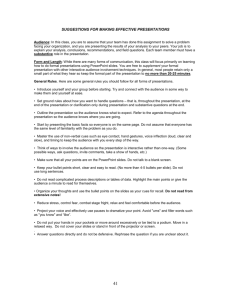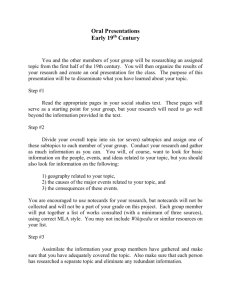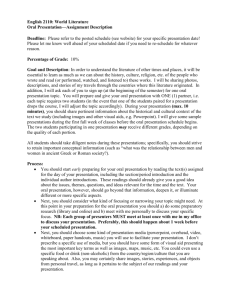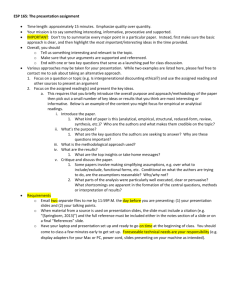Presentation Format and Abstract Guidelines
advertisement
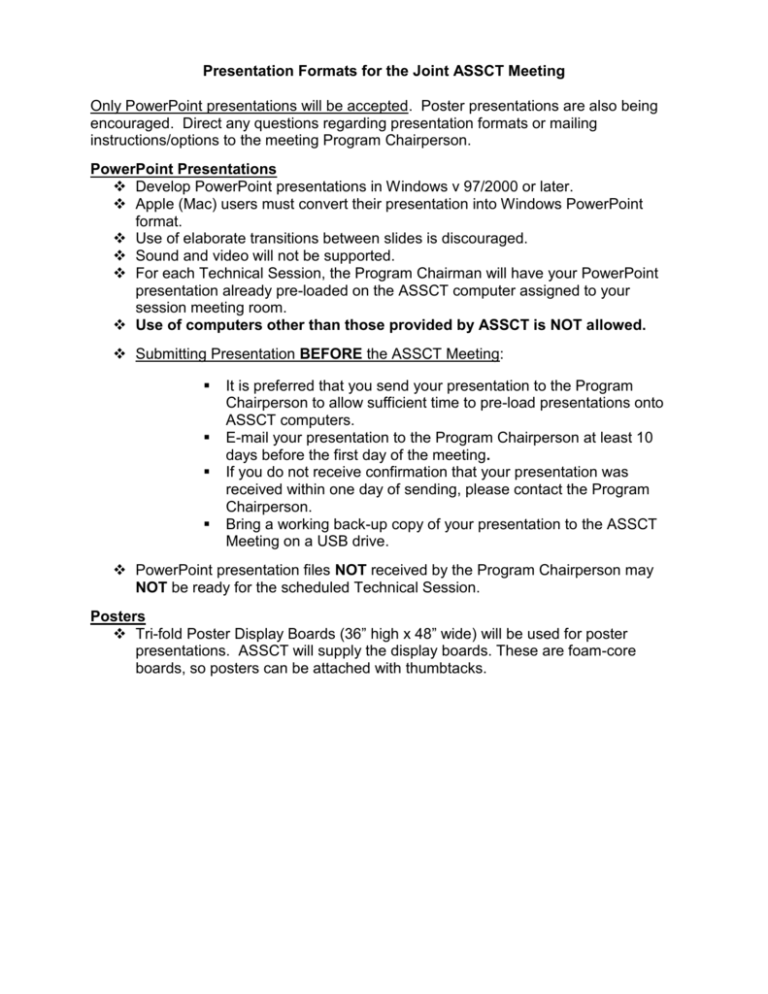
Presentation Formats for the Joint ASSCT Meeting Only PowerPoint presentations will be accepted. Poster presentations are also being encouraged. Direct any questions regarding presentation formats or mailing instructions/options to the meeting Program Chairperson. PowerPoint Presentations Develop PowerPoint presentations in Windows v 97/2000 or later. Apple (Mac) users must convert their presentation into Windows PowerPoint format. Use of elaborate transitions between slides is discouraged. Sound and video will not be supported. For each Technical Session, the Program Chairman will have your PowerPoint presentation already pre-loaded on the ASSCT computer assigned to your session meeting room. Use of computers other than those provided by ASSCT is NOT allowed. Submitting Presentation BEFORE the ASSCT Meeting: It is preferred that you send your presentation to the Program Chairperson to allow sufficient time to pre-load presentations onto ASSCT computers. E-mail your presentation to the Program Chairperson at least 10 days before the first day of the meeting. If you do not receive confirmation that your presentation was received within one day of sending, please contact the Program Chairperson. Bring a working back-up copy of your presentation to the ASSCT Meeting on a USB drive. PowerPoint presentation files NOT received by the Program Chairperson may NOT be ready for the scheduled Technical Session. Posters Tri-fold Poster Display Boards (36” high x 48” wide) will be used for poster presentations. ASSCT will supply the display boards. These are foam-core boards, so posters can be attached with thumbtacks. Abstract Submission Formats and Guidelines Abstracts submitted for papers to be presented at the annual meeting should follow the same general format as those submitted with full length papers for publication in the AMERICAN SOCIETY OF SUGAR CANE TECHNOLOGISTS JOURNAL; except they may contain multiple paragraphs. The abstracts should clearly state the author’s rationale, objectives, methods, results, and other meaning or scope of application. Be specific. Identify the crops or organisms involved, as well as soil type, chemicals, or other details that figure in interpretation of the results. Do not cite tables, figures, or references. Avoid equations unless they are the focus of the paper. Example of abstract format with authors from a single institution: Phosphorus Load Reductions Under BMPs for EAA Sugarcane R. W. Rice and F. T. Izuno Everglades Research and Education Center, University of Florida Belle Glade, FL 33430-8003 The 505,000-acre Everglades Agricultural Area (EAA) is an extremely productive agricultural basin that also serves as a major water tributary to adjacent south Florida wetlands. A 1992 regulatory program requires that annual phosphorus (P) levels in basin surface runoff be reduced by at least 25%. Growers are to collectively achieve this basin-level target through best management practices (BMPs) designed to reduce P discharges Example of abstract format with authors from multiple institutions: Deterioration of sugarcane held in overnight sleeper loads B. L. Legendre 1, H. Birkett 2, and J. Stein 2 1 USDA-ARS, Southern Regional Research Center Sugarcane Research Unit, Houma, Louisiana 2 Louisiana State University Agricultural Center Sugar Station/Audubon Sugar Institute, Baton Rouge, Louisiana The Louisiana sugar industry is experiencing yet another change in harvesting systems as it switches from the whole-stalk to combine harvesting technology primarily because of a new, high yielding variety that has a tendency to lodge. Research has also shown that burned and/or chopped cane resulting from combine harvesting deteriorates.


